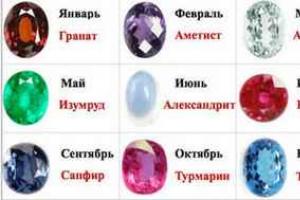The physical properties of niobium Nb are given depending on temperature in the range from -223 to 2527°C. The following properties of solid and liquid niobium are considered:
- niobium density d;
- specific mass heat capacity C p;
- thermal diffusivity coefficient a;
- coefficient of thermal conductivity λ ;
- electrical resistivity ρ ;
- coefficient of linear thermal expansion α .
The physical properties of niobium vary depending on temperature. Its change has the greatest impact on the electrical resistivity of niobium. For example, when the temperature of this metal increases from 0°C to the melting point, its resistivity increases by more than 8 times (to a value of 109·10 -8 Ohm·m).
Niobium is a ductile, refractory metal with a melting point of 2477°C and a density of 8570 kg/m 3 (at 20°C). The boiling point of niobium is 4744°C, the lattice structure is body-centered cubic with a period of 0.33 nm.
Niobium density decreases when heated. Niobium in the molten state has a density significantly lower than in the solid state: at a temperature of 2477°C, the density of liquid niobium is 7580 kg/m 3 .
The specific heat capacity of niobium at room temperature is 268 J/(kg deg) and increases when heated. Note that during melting, the value of this physical property of niobium changes slightly, and in the liquid state its specific heat capacity is 1.7 times greater than the classical value 3R.
The thermal conductivity of niobium at 0°C is 48 W/(m deg), it is close in size. The temperature dependence of the thermal conductivity coefficient of niobium is characterized by a flat minimum in the room temperature region and a positive temperature coefficient above 230°C. As niobium approaches the melting point, its thermal conductivity increases.
The thermal diffusivity of niobium also has a gentle minimum near room temperatures and then a gentle maximum at 900...1500°C. The coefficient of thermal linear expansion of niobium is relatively low. It is comparable in value to the expansion coefficient of metals such as tungsten, iridium and.
| t, °C | d, kg/m 3 |
C p , J/(kg deg) |
a·10 6 , m 2 /s |
λ, W/(m deg) |
ρ·10 8 , Ohm m |
α·10 6 , K-1 |
|---|---|---|---|---|---|---|
| -223 | — | 99 | — | — | — | 2,27 |
| -173 | — | 202 | — | 32,1 | 4,2 | 4,77 |
| -73 | — | 254 | 24,5 | 32,6 | 9,71 | 6,39 |
| 0 | — | 265 | 23,9 | 48 | 13,4 | 6,91 |
| 27 | 8570 | 268 | 23,7 | 53,5 | 14,7 | 7,07 |
| 127 | 8550 | 274 | 23,5 | 55,1 | 19,5 | 7,3 |
| 227 | 8530 | 280 | 23,9 | 57,1 | 23,8 | 7,5 |
| 327 | 8510 | 285 | 23,9 | 57,9 | 27,7 | 7,7 |
| 427 | 8490 | 289 | 23,9 | 58,6 | 31,4 | 7,9 |
| 527 | 8470 | 293 | 24 | 59,5 | 34,9 | 8,09 |
| 627 | 8450 | 297 | 24,2 | 60,8 | 38,2 | 8,25 |
| 727 | 8430 | 301 | 24,5 | 62,2 | 41,6 | 8,41 |
| 927 | 8380 | 311 | 24,7 | 64,3 | 47,9 | 8,71 |
| 1127 | 8320 | 322 | 25 | 70 | 54 | 8,99 |
| 1327 | 8260 | 335 | 25 | 69,2 | 60 | 9,27 |
| 1527 | 8200 | 350 | 25 | 71,7 | 65,9 | 9,55 |
| 1727 | 8140 | 366 | 24,6 | 73,3 | 71,8 | 9,83 |
| 1927 | 8080 | 384 | 24 | 74,5 | 77,6 | 10,11 |
| 2127 | 8020 | 404 | 24 | 77,8 | 83,3 | 10,39 |
| 2327 | 7960 | 426 | 21,7 | 73,6 | 89 | — |
| 2477 | 7580 | 450 | 18 | 65 | 109 | — |
| 2527 | — | 450 | 17,8 | — | — | — |
There are quite a large number of elements that, when combined with other substances, form alloys with special performance properties. An example is niobium, an element that was first called “columbium” (after the name of the river where it was first found), but was later renamed. Niobium is a metal with rather unusual properties, which we will discuss in more detail later.
Getting an element
When considering the properties of niobium, it should be noted that the content of this metal per ton of rock is relatively small, approximately 18 grams. That is why, after its discovery, quite a few attempts were made to obtain the metal artificially. Due to its similar chemical composition, this substance is often mined together with tantalum.
Niobium deposits are located almost all over the world. An example is the mines in Congo, Rwanda, Brazil and many other countries. However, this element cannot be called widespread; in many regions it is practically not found even in low concentrations.
The relatively small concentration of the substance in the earth's rock is aggravated by the difficulties encountered in obtaining it from concentrate. It is worth considering that NBS niobium can only be obtained from rock that is saturated with tantalum. The following are the features of the production process:
- To begin with, concentrated ore is supplied to the plant, which goes through several stages of purification. When producing niobium, the resulting ore is separated into pure elements, including tantalum.
- The final processing process involves refining the metal.
Despite the difficulties encountered in the extraction and processing of the ore in question, every year the production volume of the alloy in question increases significantly. This is due to the fact that the metal has exceptional performance qualities and is widely used in a wide variety of industries.
Niobium oxides
The chemical element in question can become the basis of various compounds. The most common is niobium pentoxide. Among the features of this connection, the following points can be noted:
- Niobium oxide is a white crystalline powder that has a creamy tint.
- The substance does not dissolve in water.
- The resulting substance retains its structure when mixed with most acids.
The features of niobium pentoxide also include the following properties:
- Increased strength.
- High refractoriness. The substance can withstand temperatures up to 1490 degrees Celsius.
- When heated, the surface oxidizes.
- Reacts to chlorine and can be reduced by hydrogen.
Niobium hydroxide is in most cases used to produce high-alloy steel grades, which have quite attractive performance properties.
Physical and chemical properties
Niobium has chemical properties similar to tantalum. When considering the main characteristics of niobium, you need to pay attention to the following points:
- Resistance to various types of corrosion. The alloys obtained by introducing this element into the composition have high corrosion-resistant qualities.
- The chemical element in question exhibits a high melting point. As practice shows, most alloys have a melting point of more than 1,400 degrees Celsius. this complicates the processing process, but makes metals indispensable in various fields of activity.
- The basic physical properties are also characterized by the ease of welding of the resulting alloys.
- At subzero temperatures, the structure of the element remains virtually unchanged, which allows the performance properties of the metal to be preserved.
- The special structure of the niobium atom determines the superconducting qualities of the material.
- The atomic mass is 92.9, the valency depends on the characteristics of the composition.
The main advantage of the substance is considered to be its refractoriness. That is why it began to be used in a wide variety of industries. The substance melts at a temperature of about 2,500 degrees Celsius. Some alloys even melt at a record temperature of 4,500 degrees Celsius. The density of the substance is quite high, 8.57 grams per cubic centimeter. It is worth considering that the metal is characterized by paramagneticity.
The following acids do not affect the crystal lattice:
- sulfuric;
- salt;
- phosphorus;
- chlorine
Does not affect metal and aqueous chlorine solutions. With a certain impact on the metal, a dielectric oxide film is formed on its surface. That is why the metal began to be used in the production of miniature high-capacity capacitors, which are also made from more expensive tantalum.
Applications of niobium
A wide variety of niobium products are manufactured, most of which are associated with the production of aircraft. An example is the use of niobium in the manufacture of parts that are installed during the assembly of rockets or aircraft. In addition, the following uses of this element can be distinguished:
- Production of elements from which radar installations are made.
- As previously noted, the alloy in question can be used to produce cheaper capacitive electrical capacitors.
- Cathodes and anodes from foil are also made using the element in question, which is associated with high heat resistance.
- You can often find designs of powerful generator lamps that have a grid inside. In order for this mesh to withstand high temperatures, it is made from the alloy in question.
High physical and chemical qualities determine the use of niobium in the production of pipes for transporting liquid metals. In addition, alloys are used to produce containers for various purposes.
Alloys with niobium
When considering such alloys, it should be taken into account that this element is often used for the production of ferroniobium. This material is widely used in the foundry industries, as well as in the manufacture of electronic coatings. Includes:
- iron;
- niobium with tantalum;
- silicon;
- aluminum;
- carbon;
- sulfur;
- phosphorus;
- titanium.
The concentration of the main elements can vary over a fairly wide range, which determines the performance of the material.
An alternative ferroniobium alloy can be called niobium 5VMC. When producing it, tungsten, zirconium and molybdenum are used as alloying elements. In most cases, this resin is used for the production of semi-finished products.
In conclusion, we note that niobium is used in the production of coins in some countries. This is due to the fairly high cost of the material. With the mass production of alloys that contain niobium as the main element, unique ingots are created.
It’s worth starting with the fact that niobium is inextricably linked with a substance such as tantalum. This is even despite the fact that these materials were not discovered at the same time.
What is niobium
What is known today about such a substance as niobium? It is a chemical element that is located in group 5 of the periodic table, having an atomic number of 41, as well as an atomic mass of 92.9. Like many other metals, this substance is characterized by a steel-gray luster.
One of the most important physical parameters of this is its refractoriness. It is thanks to this characteristic that the use of niobium has become widespread in many industries. The melting point of this substance is 2468 degrees Celsius, and the boiling point is 4927 degrees Celsius.
The chemical properties of this substance are also at a high level. It is characterized by a high level of resistance to negative temperatures, as well as to most aggressive environments.
Production
It is worth saying that the presence of ore that contains the element Nb (niobium) is much greater than that containing tantalum, but the problem lies in the scarcity of the element itself in this ore.
Most often, in order to obtain this element, a thermal reduction process is carried out, in which aluminum or silicon is involved. As a result of this operation, ferroniobium and ferrotantaloniobium compounds are obtained. It is worth noting that the metallic version of this substance is obtained from the same ore, but more complex technology is used. Niobium crucibles and other resulting materials are characterized by very high performance characteristics.

Methods for obtaining niobium
Currently, some of the most developed directions for obtaining this material are aluminothermic, sodium-thermic and carbothermic. The difference between these types also lies in the precursors that are used to reduce niobium. Let's say K2NbF7 is used in the sodium thermal method. But, for example, in the aluminothermic method, niobium pentoxide is used.
If we talk about the carbothermic method of production, then this technology involves mixing Nb with soot. This process must take place in a high temperature and hydrogen environment. As a result of this operation, niobium carbide will be obtained. The second stage is that the hydrogen environment is replaced by a vacuum, and the temperature is maintained. At this point, its oxide is added to the niobium carbide and the metal itself is obtained.

It is important to note that among the forms of metal produced, niobium in ingots is quite common. This product is intended for the production of metal-based alloys, as well as various other semi-finished products.
A stack of this material can also be produced, which is divided into several categories depending on the purity of the substance. The least amount of impurities is contained in the beaker labeled NBS-00. The NBSh-0 class is characterized by a higher presence of elements such as iron, titanium and tantalum silicon. The category that has the highest impurity indicator is NBS-1. It can be added that niobium in ingots does not have such a classification.
Alternative production methods
Alternative methods include crucibleless electron beam zone melting. This process makes it possible to obtain Nb single crystals. Niobium crucibles are produced using this method. It belongs to powder metallurgy. It is used to first obtain an alloy of this material, and then its pure sample. The presence of this method is the reason why advertisements for the purchase of niobium are quite common. This method allows you to use not the ore itself, which is quite difficult to extract, or a concentrate from it, but secondary raw materials to obtain pure metal.

Another alternative production method is niobium rolling. It is worth noting that most different companies prefer to purchase rods, wire or sheet metal.
Rolled and foil
Foil made from this material is a fairly common semi-finished product. It is the thinnest rolled sheet of this substance. Used for the production of certain products and parts. Niobium foil is obtained from pure raw materials by cold rolling of Nb ingots. The resulting products are characterized by such indicators as high resistance to corrosion, aggressive environments, and high temperatures. Rolled niobium and its ingots also provide such characteristics as wear resistance, high ductility, and good machinability.

Products obtained in this way are most often used in such fields as aircraft manufacturing, rocket science, medicine (surgery), radio engineering, electrical engineering, nuclear energy, and nuclear energy. Niobium foil is packaged in coils and stored in a dry place, protected from moisture, as well as in a place protected from mechanical influence from outside.
Applications in electrodes and alloys
The use of niobium is very widespread. It can be used, like chromium and nickel, as a material that is part of the iron alloy used to make electrodes. Due to the fact that niobium, like tantalum, is capable of forming superhard carbide, it is often used to produce superhard alloys. It can be added that they are currently trying to use this material to improve the properties of alloys obtained on the basis

Since niobium is a raw material capable of creating carbide elements, it, like tantalum, is used as an alloying mixture in the production of steel. It is worth noting that for a long time the use of niobium as an impurity in tantalum was considered a negative effect. However, today the opinion has changed. It was found that Nb can act as a substitute for tantalum, and with great success, since due to its lower atomic mass, smaller amounts of the substance can be used, while maintaining all the old capabilities and effects of the product.
Applications in electrical engineering
It is worth emphasizing that the use of niobium, like its brother tantalum, is possible in rectifiers due to the fact that they have the property of unipolar conductivity, that is, these substances pass electrical current only in one direction. It is possible to use this metal to create devices such as anodes, which are used in powerful generators and amplification tubes.
It is very important to note that the use of niobium has reached nuclear power. In this industry, products made from this substance are used as structural materials. This became possible because the presence of Nb in the parts makes them resistant to heat and also gives them high chemical resistance qualities.

The excellent physical characteristics of this metal have led to its widespread use in rocketry, jet aircraft, and gas turbines.
Niobium production in Russia
If we talk about the reserves of this ore, there are about 16 million tons in total. The largest deposit, occupying approximately 70% of the total volume, is located in Brazil. About 25% of the reserves of this ore are located in Russia. This indicator is considered a significant part of all niobium reserves. The largest deposits of this substance are located in Eastern Siberia, as well as in the Far East. Today, on the territory of the Russian Federation, the Lovozersky GOK company is engaged in the extraction and production of this substance. It can be noted that the Stalmag company was also involved in the production of niobium in Russia. It developed the Tatar deposit of this ore, but was closed in 2010.
You can also add that it is engaged in the production of niobium oxide. They obtain it by processing loparite concentrate. This enterprise produces from 400 to 450 tons of this substance, most of which is exported to countries such as the USA and Germany. Part of the remaining oxide goes to the Chepetsk Mechanical Plant, which produces both pure niobium and its alloys. There are significant capacities there, allowing the production of up to 100 tons of material per year.
Niobium metal and its cost
Despite the fact that the scope of application of this substance is quite wide, its main purpose is the space and nuclear industries. For this reason, Nb is classified as a strategic material.
The main parameters that affect the cost of niobium:
- purity of the alloy, a large number of impurities reduces the price;
- form of material delivery;
- volumes of supplied material;
- location of the ore receiving point (different regions need different amounts of the element, and therefore the price for it is different).
Approximate list of prices for materials in Moscow:
- niobium grade NB-2 costs between 420-450 rubles per kg;
- niobium shavings cost from 500 to 510 rubles per kg;
- a stick of the NBSh-00 brand costs from 490 to 500 rubles per kg.
It is worth noting that, despite the enormous cost of this product, the demand for it is only increasing.
Niobium is one of the most refractory metals. In the mid-16th century, a heavy black mineral with golden mica veins was discovered in North America. It was sent to England, where the mineral lay for almost 150 years in the British Museum. In 1801, the chemist Hatchet began researching it, who discovered in it iron and some unknown substance with the properties of an acid oxide. Hatchet named the new element columbium, and the mineral columbite, after its location. A year later, in 1802, the Swedish researcher Ekeberg found another new substance in some Scandinavian and Finnish minerals, which he named tantalum. This name was given in honor of one of the heroes of Greek mythology. Tantalum turned out to be very close in its properties to columbium, so many scientists argued that columbium and tantalum were the same thing. In fact, both Hatchet and Ekeberg discovered a mixture of tantalum and columbium, in which columbium predominated in one case, and tantalum in the other. Some clarity was brought only in 1844, when Rose discovered two elements in one mineral - tantalum and columbium, to which he gave the name niobium. Pure tantalum was first obtained in 1903, and pure niobium even later. Niobium, like vanadium, belongs to Group V of the periodic table. However, unlike vanadium, niobium is much more difficult to reduce to lower degrees of valence. Therefore, we have to deal with their pentavalent compound, as the most stable, as follows from the structure of the electronic shells of atoms: niobium - 2,8,18,12,1.Metallic Niobium resembles platinum in appearance. The microhardness of metallic niobium is 88 kg/mm2.
Main characteristics of niobium:
 The most valuable property that determines the use of niobium is, first of all, its exceptional resistance to acids: niobium does not dissolve in aqua regia and concentrated nitric acid. Concentrated sulfuric acid completely dissolves niobium when heated. Niobium dissolves in a mixture of nitric and hydrofluoric acids, but hydrofluoric acid alone acts slowly on niobium. Alkali solutions have almost no effect on niobium. Niobium reacts with molten alkalis to form salt-niobates. Melts of some salts and various organic compounds have no effect on niobium at all. Another special and important property of metallic niobium is the ability to absorb gases - hydrogen, nitrogen and others - with the formation of corresponding solid solutions, which are interstitial phases. Niobium is capable of forming hydrides. In the Nb-H system, only one chemical compound was found, namely NbH. The solubility of hydrogen in niobium drops sharply with increasing temperature. This is shown in the graph on the left
The most valuable property that determines the use of niobium is, first of all, its exceptional resistance to acids: niobium does not dissolve in aqua regia and concentrated nitric acid. Concentrated sulfuric acid completely dissolves niobium when heated. Niobium dissolves in a mixture of nitric and hydrofluoric acids, but hydrofluoric acid alone acts slowly on niobium. Alkali solutions have almost no effect on niobium. Niobium reacts with molten alkalis to form salt-niobates. Melts of some salts and various organic compounds have no effect on niobium at all. Another special and important property of metallic niobium is the ability to absorb gases - hydrogen, nitrogen and others - with the formation of corresponding solid solutions, which are interstitial phases. Niobium is capable of forming hydrides. In the Nb-H system, only one chemical compound was found, namely NbH. The solubility of hydrogen in niobium drops sharply with increasing temperature. This is shown in the graph on the left
Niobium also dissolves oxygen in amounts up to 0.8% by weight. Solubility in niobium at different temperatures was studied in detail by Steybolt, who showed the change in hardness with increasing oxygen content in the metal. Apparently, some of the oxygen is in the metal in the form of a solid solution, and some forms an oxide; The study of the niobium-oxygen system is especially important in connection with research on the use of these metals as heat-resistant, refractory structural materials. Niobium and tantalum form alloys with many metals. Special attention is now being paid to the study of these alloys due to the fact that many of them have particularly valuable qualities and are therefore of great practical importance.
Unlike its analogue vanadium, niobium is much less prone to transition to lower valence states, and tantalum is generally not known in solution with a valence below 5. Therefore, the reduction of niobium and tantalum to metals by electrolysis of aqueous solutions is unlikely. Niobium, however, can be reduced to tetravalent by electrolysis with a mercury cathode or zinc amalgam. This is used for analytical purposes, titrating reduced niobium with permanganate or reducing niobium before the hydrolytic precipitation of tantalum in order to separate it from niobium. According to recent data, by electrolysis of niobium sulfate solutions it is possible to separate it from tantalum, taking advantage of the fact that reduced niobium precipitates from solution when adding sulfate ammonium in the form of a salt of the expected composition containing tri- and tetravalent niboium in a ratio of 1:2.
Electrolysis is also used to isolate indicators of the amounts of radioactive isotopes of niobium. Niobium can be reduced to metal by electrolysis of melts. The polarographic behavior of niobium has been studied repeatedly, but has not yet received widespread practical application. Some researchers believe that the waves observed in acidic niobium solutions are catalytic in nature, since their height is significantly greater than the theoretical one.
In accordance with its position in the periodic table, niobium forms acidic oxides. Compared to vanadium - its higher analogue - niobium has pronounced acidic properties. However, in nature they are found only in the form of salts of their acids, and therefore for a long time they retained the name earth acids or “acid earths.”
Nb2O5 pentoxide appears as white finely crystalline powders, practically insoluble in water and very refractory. Nb2O5 is obtained by direct oxidation of metallic niobium. Powdered metallic niobium burns in a stream of oxygen to pentoxide already at 400 °C. The heat of formation is 455.2 kcal/mol. Niobium also forms complex compounds of various types, in particular with organic acids. Niobium is also included in the outer sphere of some heteropolyacids, for example phosphomolybdic and silicomolybdic, which must be taken into account in the colorimetric determination of silicon and phosphorus using these compounds in the presence of niobium. In connection with the need to obtain metallic niobium of high frequency, interest arose in its iodide. Niobium and tantalum iodides can be obtained by an exchange reaction between aluminum or silicon iodides and niobium and tantalum chlorides at 300-400 °C. According to the latest data, niobium iodide is crystals with a bronze luster, easily hydrolyzed by water and air moisture, and does not melt or volatilize at temperatures up to 300 ° C. Niobium and tantalum form carbides of various compositions. Niobium and tantalum monocarbides are used for the manufacture of certain grades of hard alloys, for heating elements of various high-temperature installations and for some other purposes. You can buy niobium at the lowest price by clicking on the links below.
Niobium pentafluorides.
Niobium pentafluorides are strong Lewis acids; they catalyze Friedel-Crafts reactions and form niobium adducts with a wide variety of neutral and anionic compounds. Unlike similar reactions of other niobium pentahalides, these reactions are generally addition reactions; substitution of a halogen in a pentafluoride molecule or a change in the valence of the central metal atom occurs rarely. The melting point of niobium pentafluorides is very different. The viscosity of molten niobium pentafluorides is almost 250 times higher than the viscosity of water under the same temperature conditions, which indicates a high degree of association of molecules in the melts.
Applications of niobium
Buy niobium
You can always purchase niobium products at the lowest prices on the domestic market. Products manufactured on modern foreign equipment of well-known brands, taking into account compliance with international quality certificates ISO, domestic GOST and TU, are the most competitive in the entire Ural region. On the company’s website you can always order: niobium wire, niobium rod, niobium rod, niobium sheet. We accept and process all your orders on time. In our company you can always purchase tungsten and its alloys following brands:
5V2MC-1, 5VMC, 5VMC-2, 5V2M, 5VM, NTs2, NTs-2-1, 10VTs, SB-1, SB-U, VN2, VN2A, VN3, VN4, VN6, NAZH-1, NAZH-2, NBA-0, NBA-1, NBA-1V, NB1, NB2, Nb5VMC, Nb5V2MC, NBTs, NBP1, NBSh, NSh00,
NBSh1, NHF, ONB, RN-8.
We offer to buy the following niobium products:
- niobium,
- niobium circle,
- niobium wire,
- niobium rod.








